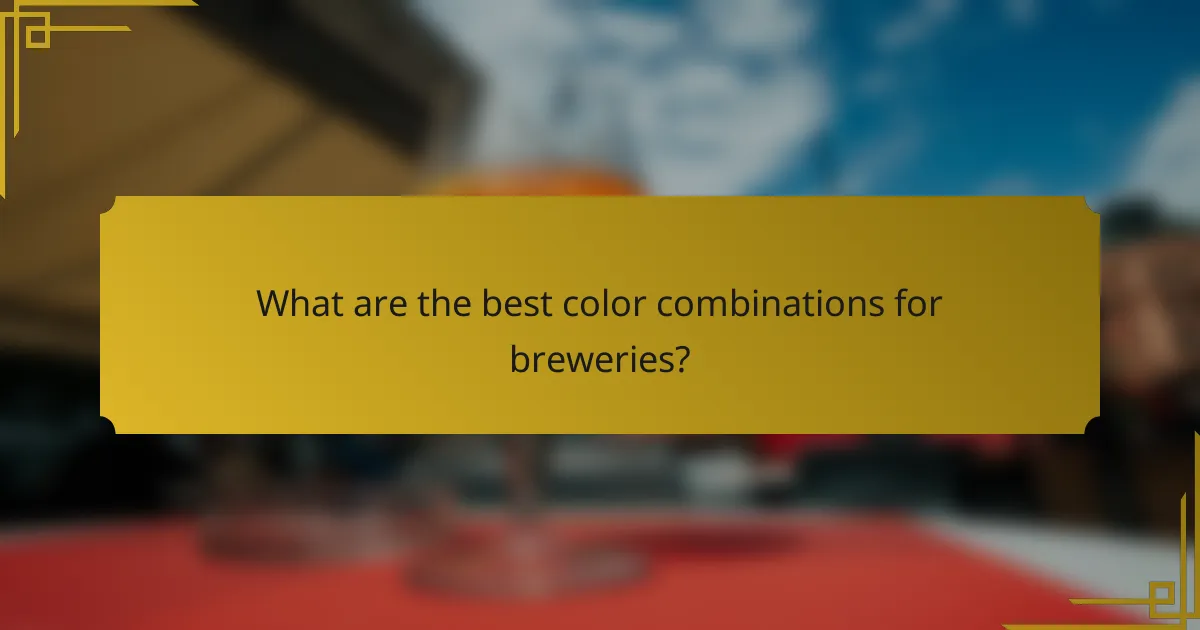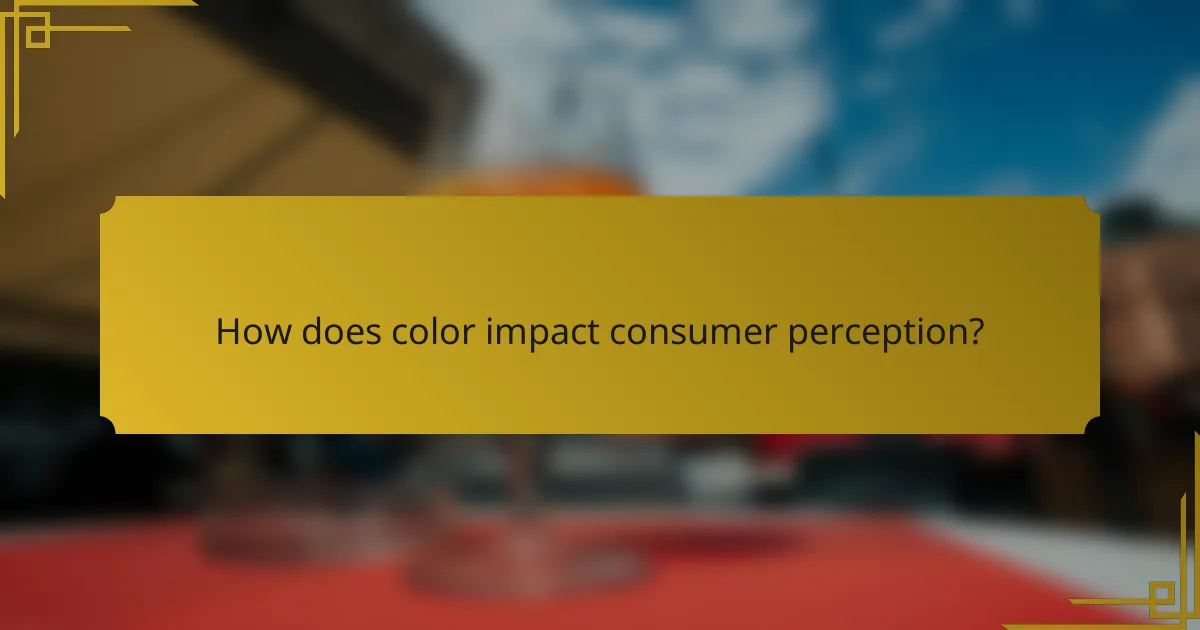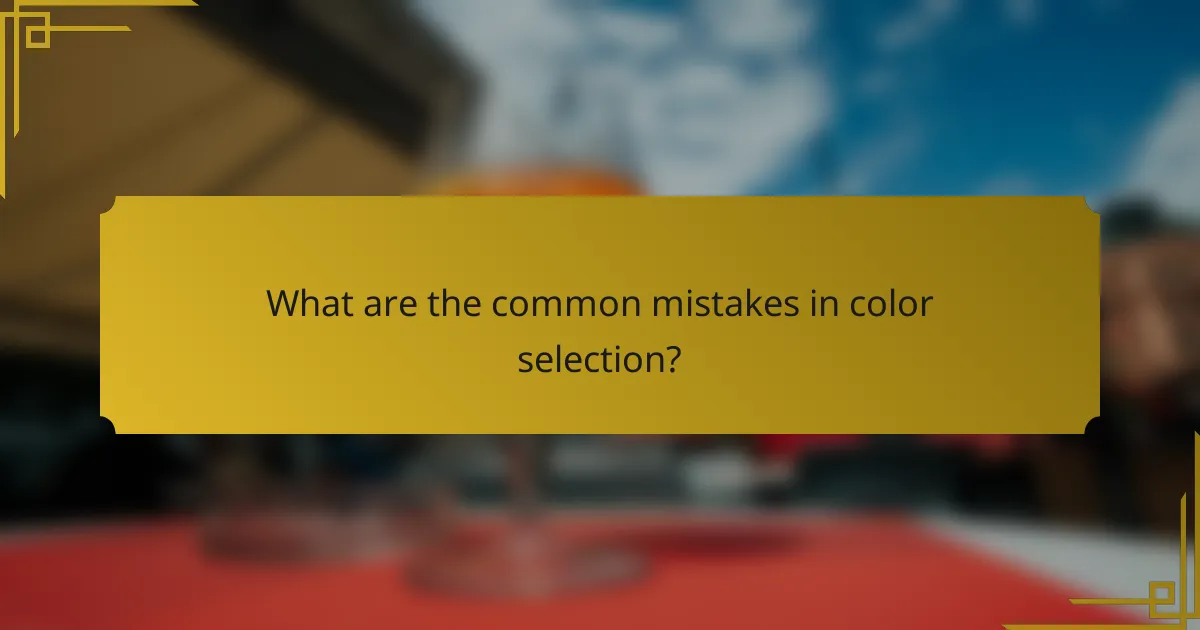Choosing a color palette for your brewery brand is crucial in aligning your visual identity with your core values and audience expectations. The right color scheme not only enhances brand recognition but also influences customer perceptions and emotions, ultimately shaping their experience. By carefully selecting colors that reflect your brand’s identity and resonate with your target demographic, you can create a memorable and impactful presence in the market.

How to Choose a Color Palette for Your Brewery Brand?
Choosing a color palette for your brewery brand involves aligning your visual identity with your brand values and audience expectations. A well-selected color scheme can enhance brand recognition and influence customer perceptions.
Understand brand identity
Your brand identity is the foundation of your brewery’s image, encompassing your mission, values, and personality. Start by defining what your brewery stands for and how you want to be perceived. For example, a craft brewery focused on sustainability might opt for earthy tones, while a modern brewery could choose vibrant, bold colors.
Consider creating a mood board that visually represents your brand identity. This can help you visualize how different colors reflect your brand’s essence and guide your color selection process.
Analyze target audience preferences
Understanding your target audience is crucial in selecting a color palette that resonates with them. Conduct surveys or focus groups to gather insights on color preferences among your potential customers. For instance, younger audiences may prefer brighter, more energetic colors, while older demographics might lean towards classic, muted tones.
Keep in mind regional preferences as well. For example, breweries in coastal areas might find that blues and greens appeal more to local customers, while those in urban settings could benefit from more industrial or edgy color choices.
Consider beer styles and flavors
The styles and flavors of your beers can significantly influence your color palette. For instance, a brewery specializing in stouts and porters might choose darker, richer colors like deep browns and blacks, while a brewery known for light ales could opt for lighter, refreshing colors like yellows and pale blues.
Aligning your color choices with the sensory experience of your beers can create a cohesive brand image. Use colors that evoke the flavors and aromas of your brews, enhancing the overall customer experience.
Evaluate competitor color schemes
Analyzing the color schemes of your competitors can provide valuable insights and help you differentiate your brand. Take note of the colors commonly used in your local market and identify gaps where your brewery can stand out. For example, if most local breweries use earthy tones, a bright, modern palette could attract attention.
However, avoid copying competitors directly. Instead, aim to create a unique color identity that reflects your brand while still appealing to your target audience.
Utilize color psychology
Color psychology plays a significant role in how consumers perceive brands. Different colors evoke different emotions and associations. For example, blue is often associated with trust and reliability, while red can evoke excitement and passion. Consider how you want your brewery to be perceived and choose colors that align with those feelings.
Incorporate a mix of colors to create a balanced palette that communicates your brand message effectively. A well-thought-out color scheme can enhance customer engagement and loyalty, making it a vital aspect of your branding strategy.

What are the best color combinations for breweries?
The best color combinations for breweries often reflect the brand’s identity and target audience. Earthy tones, bold colors, and classic palettes each convey different messages and appeal to various demographics.
Earthy tones for craft breweries
Earthy tones, such as browns, greens, and muted yellows, are ideal for craft breweries aiming to evoke a sense of authenticity and connection to nature. These colors resonate well with consumers who appreciate organic and locally sourced products.
When selecting earthy tones, consider using a combination of deep greens with warm browns to create a cozy and inviting atmosphere. This palette can help communicate the brewery’s commitment to sustainability and craftmanship.
Bold colors for modern brands
Bold colors like vibrant reds, blues, and yellows can effectively capture attention and convey a sense of energy and innovation. Modern breweries often use these striking combinations to stand out in a competitive market.
To create a memorable brand, pair bold colors with clean, minimalist designs. For example, a bright blue with a crisp white can create a fresh and contemporary look that appeals to younger audiences.
Classic palettes for traditional breweries
Classic color palettes, including deep reds, golds, and dark greens, are often associated with traditional breweries that focus on heritage and craftsmanship. These colors can evoke a sense of nostalgia and reliability.
When using classic palettes, consider incorporating metallic accents like gold or bronze to enhance the premium feel. This approach can attract consumers looking for quality and authenticity in their beer choices.

How does color impact consumer perception?
Color significantly influences consumer perception by affecting their emotions, thoughts, and even taste expectations. The right color palette can enhance brand identity and create a memorable experience for customers, making it essential for breweries to choose wisely.
Influence on taste perception
Colors can shape how consumers perceive the taste of a beverage. For instance, warm colors like red and orange are often associated with sweetness, while cooler colors like blue and green may suggest bitterness or freshness. This means that a brewery’s color scheme can set expectations before the first sip.
When designing labels or taproom decor, consider using colors that align with the flavor profiles of your beers. For example, a bright yellow might suggest a fruity, light lager, while deep brown could evoke a rich stout. This alignment can enhance the overall tasting experience.
Emotional responses to colors
Colors evoke specific emotional responses that can influence consumer behavior. For example, blue often conveys trust and reliability, making it a popular choice for brands aiming for a professional image. In contrast, red can stimulate excitement and urgency, which may encourage quicker purchasing decisions.
Breweries should assess the emotions they want to evoke in their customers. A relaxed atmosphere may benefit from earthy tones, while a vibrant, energetic space could utilize brighter colors. Testing different palettes can help identify which colors resonate best with your target audience.
Brand recognition and recall
Consistent use of color in branding enhances recognition and recall among consumers. Studies show that color can increase brand recognition by up to 80%. A unique color palette can set a brewery apart in a crowded market, making it easier for customers to remember and recommend.
When selecting colors, aim for a cohesive look across all branding materials, including labels, merchandise, and social media. This consistency reinforces brand identity and helps build a loyal customer base. Consider creating a style guide that outlines your color choices and their intended emotional impacts.

What tools can help in selecting a color palette?
Several tools can assist you in selecting a color palette for your brewery brand, making the process easier and more effective. These tools offer features for creating, generating, and visualizing color schemes that align with your brand identity.
Adobe Color for palette creation
Adobe Color is a powerful tool for creating custom color palettes. Users can explore various color rules such as analogous, monochromatic, and complementary to find combinations that resonate with their brand image. The intuitive interface allows you to adjust colors and see how they work together in real-time.
When using Adobe Color, consider the emotional impact of colors on your audience. For example, warm colors like reds and oranges can evoke feelings of excitement, while cooler tones like blues and greens can convey calmness. Aim for a palette that reflects the atmosphere you want to create in your brewery.
Coolors for color scheme generation
Coolors is an easy-to-use color scheme generator that helps you quickly create and refine color palettes. You can start with a base color and generate complementary shades, or explore trending palettes for inspiration. The lock feature allows you to keep certain colors while adjusting others, making it simple to experiment.
Utilize Coolors to ensure your color choices are versatile across different applications, such as labels, merchandise, and digital platforms. A good practice is to create a palette of three to five colors that can be consistently used in your branding materials.
Canva for mockup designs
Canva is an excellent tool for visualizing your color palette in mockup designs. With its user-friendly interface, you can easily apply your selected colors to various templates, such as beer labels, promotional materials, and social media posts. This helps you see how the colors work in real-world applications.
When designing with Canva, keep in mind the importance of contrast and readability. Ensure that text is legible against background colors, especially for labels and signage. Test your designs in both digital and print formats to confirm that colors appear as intended across different mediums.

What are the common mistakes in color selection?
Common mistakes in color selection for a brewery brand include failing to maintain brand consistency and overcomplicating color schemes. These errors can dilute brand identity and confuse customers, ultimately affecting brand recognition and loyalty.
Ignoring brand consistency
Brand consistency is crucial in color selection as it helps create a cohesive identity across all marketing materials. When colors vary significantly between products or platforms, it can lead to customer confusion and weaken brand recognition.
To maintain consistency, choose a primary color palette that reflects your brewery’s personality and stick to it across all branding elements, including labels, merchandise, and online presence. A good rule of thumb is to limit your palette to two or three primary colors and a few complementary shades.
Overcomplicating color schemes
Overcomplicating color schemes can overwhelm potential customers and detract from your brand message. A cluttered palette may confuse consumers about your offerings and make it harder for them to remember your brand.
Keep your color scheme simple and focused. Aim for a maximum of three to five colors that work well together and convey the desired emotions associated with your brewery. For example, earthy tones can evoke a sense of tradition, while vibrant colors may suggest innovation and excitement.
